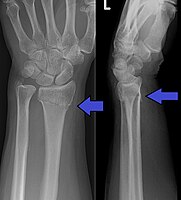
Photo from wikipedia
Study Design. Retrospective analysis of computed tomographic images of 92 normal pediatric cervical vertebrae. Objective. The aim of this study was to ascertain the feasibility of the pedicle, intralaminar, and… Click to show full abstract
Study Design. Retrospective analysis of computed tomographic images of 92 normal pediatric cervical vertebrae. Objective. The aim of this study was to ascertain the feasibility of the pedicle, intralaminar, and lateral mass screws fixation in children. Summary of Background Data. Fixation techniques of C7 vertebrae are technically challenging in the pediatric population. Although the techniques offer alternatives to screws placement at C7 spine in adult, there is no consensus to apply these screws in children. Methods. A total of 92 patients (59 males and 33 females) from 3- to 16-year old divided into three groups (group 1, 1–6 years; group2, 7–10 years; group 3, 11–16 years) were included. Measurements were taken through computed tomography (CT) imaging without evidence of spinal trauma. Length, width, and angle of lamina and pedicle were measured, and lateral mass length was also assessed. Results. There was no statistical difference between the left and right sides, as well as the sexes. In 1 to 6 years’ age group, 83.3% of the laminas and 87.5% of the pedicles measured have thicknesses of >3.5 mm. In 7 to 10 years’ age group, 84.0% of the laminas and all the pedicles observed have thicknesses of >3.5 mm. In 11 to 16 years’ age group, 88.4% of the laminas and 97.7% of the pedicles measured have thicknesses of >3.5 mm. Most of the spinolaminar angles were between 42.5° and 56°. There are three cases (3.3%) having lateral mass length >12 mm. Conclusion. It is feasible to insert a screw (Ø 3.5 mm) in C7 lamina in children, and the intralaminar screw fixation is a safe and reliable technique. Around 49°, the spinolaminar angle with axial position, can be used as reference for placing screws in the C7 lamina. Preoperative CT scan will help surgeons to insert the laminar screw safely and accurately. Level of Evidence: N/A
Journal Title: SPINE
Year Published: 2018
Link to full text (if available)
Share on Social Media: Sign Up to like & get
recommendations!